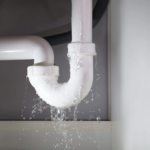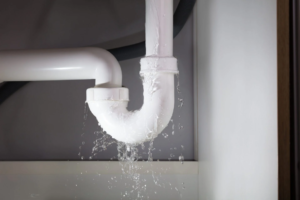Did you know that about 10% of homes in the U.S. experience some form of water damage due to pipe corrosion each year? Spotting early signs of corrosion can save you from costly repairs and potential health hazards. You might notice discolored water or a drop in water pressure, but there's more to look for. It's not just about the visible signs—unusual odors and sounds can also be indicators. Understanding these warning signs is essential for maintaining your home's plumbing integrity. So, what are the subtle clues you should be aware of?
Key Takeaways
- Check for discolored water with a yellow, brown, or reddish tint.
- Notice any unusual or unpleasant odors coming from your water.
- Inspect pipes for visible damage like rust, flaking, or leaks.
- Monitor for reduced water pressure in your home.
- Listen for unusual noises such as banging or gurgling in the plumbing system.
Discolored Water
One of the earliest signs of pipe corrosion in your home is discolored water. When you turn on the tap, you might notice a yellow, brown, or even reddish tint to the water. This discoloration often stems from rust that has built up inside the pipes. As the pipes degrade, rust particles mix with the water, altering its appearance. You may observe this change particularly when you haven't used the water for a while, like first thing in the morning or after returning from a trip.
To check for pipe corrosion, fill a clear glass with water and let it sit for a few minutes. If the color settles to the bottom or the water appears cloudy, it's a strong indicator of corrosion. Consistently discolored water can also hint at older pipes needing urgent attention.
Another step is to look at the water's clarity under different conditions. For instance, if cold water looks fine but hot water is discolored, the issue might be with your water heater instead. Staying aware of this symptom can help you address potential plumbing problems before they escalate, ensuring your home's water quality remains safe and clean.
Unpleasant Odors
Frequently, unpleasant odors can be a telltale sign of pipe corrosion in your home. When corrosion occurs, it often leads to the buildup of rust and sediment inside the pipes. This can result in foul smells emitting from your sinks, drains, and even the water itself. If you notice a persistent, unusual odor, it's time to investigate further.
Here are some key indicators that the smell might be linked to pipe corrosion:
- Metallic scent: A sharp, metallic odor could suggest rusting pipes.
- Sulfur smell: A rotten egg-like smell is often associated with corroded pipes where bacteria produce hydrogen sulfide gas.
- Musty odor: This could indicate mold growth resulting from leaks due to pipe corrosion.
- Chemical-like smell: A sharp chemical odor might signal that the corrosion is reacting with certain substances in your water.
- Stale water scent: If water smells stale, it might be a sign of stagnation and internal corrosion.
Pay attention to where these odors are strongest. They usually intensify near the source of the corrosion. Addressing these smells promptly can help prevent more severe plumbing issues down the line, saving you time and money.
Visible Pipe Damage
Spotting visible pipe damage is essential when evaluating potential corrosion issues in your home. When you inspect your pipes, look for any noticeable changes in appearance. Rust, discoloration, or flaking on the pipe surface often indicate corrosion. These signs are usually the result of long-term exposure to moisture, leading to oxidation.
Don't overlook the connections and joints, as they can be particularly vulnerable to damage. Leaks or damp spots around these areas could suggest that corrosion has weakened the integrity of the pipes. Additionally, pay close attention to any warping or bulging, which might signify that the pipe walls have thinned due to corrosion.
Here's a quick reference table to help you identify visible pipe damage:
| Signs | Description | What It Indicates |
|---|---|---|
| Rust | Reddish-brown spots on pipes | Oxidation and possible corrosion |
| Discoloration | Changes in pipe color | Potential water exposure |
| Flaking | Layers peeling off the pipe | Advanced corrosion |
| Leaks | Water escaping at connections | Weakening of pipe joints |
| Warping/Bulging | Curved or swollen pipe surfaces | Thinned walls due to corrosion |
Reduced Water Pressure
Ever wondered why your shower feels less powerful than before? Reduced water pressure can be a telltale sign of pipe corrosion in your home. Corroded pipes restrict water flow, making it difficult for water to travel at its usual force. You might notice the change gradually, but it's important to act quickly. By addressing the issue early, you can prevent further damage and restore your water pressure to its former glory.
Here's how you can identify if corrosion is affecting your water pressure:
- Check multiple faucets: If the problem is widespread, it's likely a pipe issue.
- Examine water flow consistency: Does the pressure fluctuate or remain low?
- Inspect the water heater: Corrosion might be reducing efficiency here, too.
- Observe pipe material: Older, galvanized steel pipes are more prone to corrosion.
- Look for sediment buildup: This can clog pipes, decreasing water pressure.
Unusual Noises
If you're hearing odd sounds like banging, gurgling, or whistling coming from your pipes, it might be a sign of corrosion. These unusual noises indicate that the water flow is being disrupted, possibly due to rust or mineral buildup inside the pipes. When water doesn't have a clear path, it creates air pockets or pressure changes that result in these strange sounds.
Banging noises, often called "water hammer," occur when water flow suddenly stops or changes direction, hitting against the pipe walls. This can happen when corrosion narrows the pipe, causing abrupt changes in pressure. Gurgling may suggest trapped air or water struggling to pass through a partially blocked section. Whistling sounds are usually due to water being forced through a narrow opening, indicative of corrosion-induced constriction.
To identify where the sound originates, listen closely at various points along your plumbing system. Pay attention to specific times, like when you turn on a faucet or when appliances run, as this can help pinpoint the issue. Addressing these noises early can prevent further damage and costly repairs. Consult a professional plumber to assess the situation and recommend the best course of action.
Water Stains
Water stains are an unmistakable sign of pipe corrosion in your home. When pipes corrode, they often leak, leaving unsightly marks on walls, ceilings, or floors. These stains not only look unpleasant but can also indicate underlying plumbing issues. It's essential to recognize these signs early to prevent further damage. So, what should you look for?
- Discoloration: Check for yellow, brown, or copper stains, as these hues are common indicators of rust.
- Shape: Water stains often appear in irregular forms, spreading outwards like a spill.
- Location: Examine areas near plumbing fixtures, such as under sinks or around toilets, where leaks are more probable.
- Texture: Notice any bubbling, peeling, or softening of the paint or wallpaper, which might suggest water damage beneath the surface.
- Odor: A musty smell can accompany water stains, hinting at mold growth due to moisture.
Increased Water Bills
A sudden spike in your water bill can be a red flag for hidden pipe corrosion. When pipes corrode, they may develop leaks that aren't immediately visible, allowing water to escape unnoticed. This not only wastes water but also ramps up your monthly bill. If you've not changed your water usage habits, yet notice a significant increase in costs, it's time to investigate your plumbing.
Start by checking for visible leaks under sinks, around toilets, and in your basement or crawl spaces. Don't forget to examine outdoor faucets and irrigation systems. Sometimes, the corrosion isn't obvious, but a closer look might reveal rust-colored water stains or damp spots. You should also listen for the sound of running water when all fixtures are off, which might indicate a hidden leak.
If you can't find any visible signs, it might be wise to call a professional plumber. They have the tools and expertise to detect leaks inside walls or underground. By acting swiftly, you can prevent further damage and save money in the long run. Ignoring the problem will only lead to more costly repairs and higher water bills.


